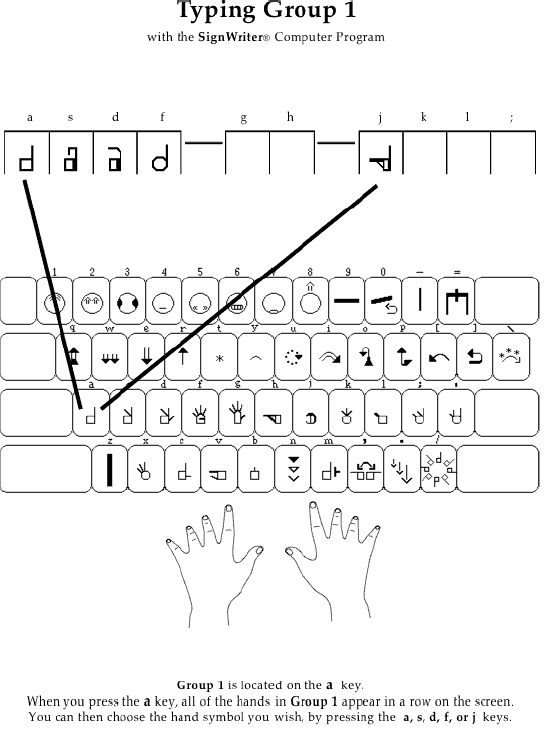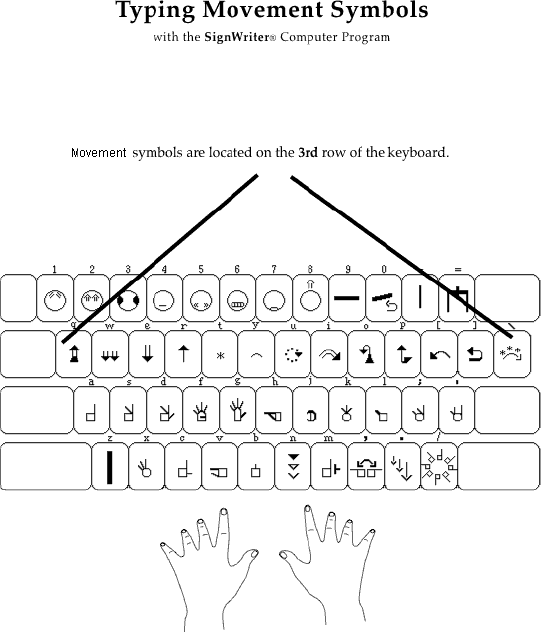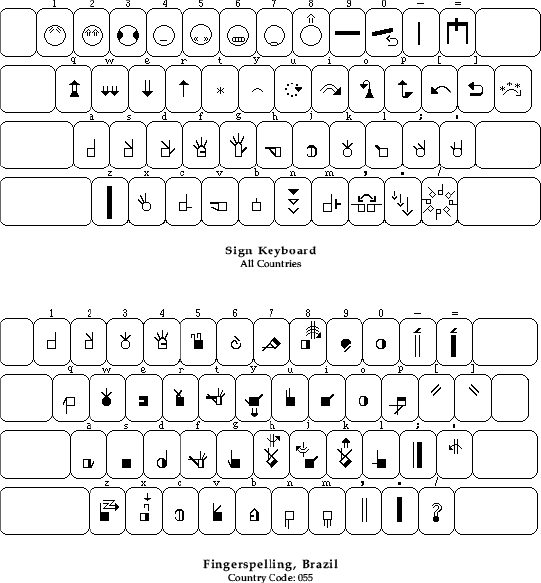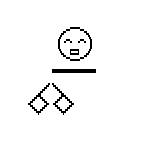Abstract
This paper reviews the design history of SignWriter,
a word processor for the SignWriting system.
While the primary goal of SignWriter was simply
to create a word processor for SignWriting,
its development and subsequent use had several
beneficial effects on the SignWriting system.
Various design aspects of SignWriter are considered
in the context of current computing technologies
and sign processing development efforts.
Background
The SignWriting system [Sutton04] was conceived,
developed, and used for many years as a hand-written
notation. In particular, its use predated the
introduction of low-cost personal computers.
In 1984 Emerson and Stern Associates, a small
educational research and development firm, received
a grant to develop a word processor for SignWriting.
The resulting software, which operated on an
Apple II computer, supported only a minor subset
of the SignWriting system and was more of a
demonstration than a useful tool: it was not
subsequently used, and received no further development.
The application was notable for displaying the
symbols in a virtual "picture frame"
around a central editing area, with symbols
selected for entry by moving a cursor around
the frame until the desired symbol was reached.
Emerson and Stern's software design implied
that SignWriting was too complex for the personal
computers of the time. Interestingly, their
response was to devise an entirely different
writing system named SignFont [Newkirk87], which
traded computational simplicity - it was designed
as a standard Macintosh font -for notational
obscurity. SignFont's subsequent nonuse suggests
that this design tradeoff was unsuccessful.
SignWriter Apple
It was in this context that SignWriter was conceived
in 1986. The intended use for SignWriter was
in education and the hardware platform was once
again the Apple II, which at the time was an
established standard for personal computing.
The design goal was to implement the full SignWriting
system in a simple but complete and usable word
processor.
This more ambitious goal could be attempted
on the same hardware because as a former member
of the UCSD Pascal project, Richard Gleaves
had several years of experience developing system
software for the Apple II, and knew how to program
in assembly language and make full use of the
Apple's 128KB memory. In addition Gleaves’
Pascal project colleague Mark Allen provided
some high-performance graphics routines that
he had developed for writing arcade-style games
on the Apple II.
Much of the design effort in SignWriter was
spent on two issues:
… Developing a memory-efficient encoding
for SignWriting text
… Devising user interface mechanisms for
efficiently typing symbols
SignWriting symbols were encoded using a variable-length
byte-code system that was introduced in UCSD
Pascal p-code [Bowles78] and later adopted for
use in Java object code. The SignWriter graphics
engine interpreted the byte codes as instructions
for drawing symbols on the screen in specific
locations and orientations.
Typing was chosen as the input mode for two
reasons. First, while mice were available for
the Apple II they were an optional add-on and
therefore most Apple IIs did not have them.
Second, the SignWriting system was receiving
criticism at the time for allegedly being a
formof illustration rather than a true writing
system. Therefore an efficient typing mechanism
would cause SignWriter to serve as implicit
proof that SignWriting was indeed a form of
writing.
It was evident that SignWriting's complex symbol
set would prevent it from being typed as efficiently
as the Roman alphabet on a standard keyboard.
However, the design that evolved -which involved
the context-sensitive dynamic redefinition of
the keyboard keys yielded a valuable tradeoff
of efficiency for learnability. The key boxes
displayed on the screen highlighted the natural
categories of the SignWriting symbols in a manner
that allowed the typing mechanism to serve as
an implicit learning tool: a crucial property
given the symbol set complexity and the application's
intended audience. See Figures 1, 2 and 3 from
the SignWriter-At-A-Glance Instruction Manual.
(at end of article)
The SignWriting symbol images were created by
Valerie Sutton using the SignWriter symbol editor
program. In addition she defined the mapping
of SignWriting symbols to the keyboard keys.
As with the key boxes, this mapping emphasized
learnability by grouping symbols according to
their natural categories. Conversely, the mapping
of the key box keys and symbol attribute keys
(Arrow, Cursor, Mirror, Size, and Rotate) was
determined strictly by typing efficiency.
SignWriter's Find and Replace commands were
implemented (at significant expense in memory)
both to establish SignWriter as a complete word
processor and again to demonstrate SignWriting's
status as a true writing system. Unfortunately
the search algorithm did not take into account
the relative positioning of symbols within a
sign, thus making the search feature itself
more of a demonstration than a useful tool.
Because SignWriter was developed as a stand-alone
application, it was free to possess an application-specific
user interface. The interface design was influenced
by Tufte's principle of graphical minimalism
[Tufte83]: namely, every pixel that was not
part of a SignWriting symbol existed onscreen
only because it was functionally necessary.
While this design approach may seem austere
given today's large color displays, it made
for a simple and easy-to-use interface on the
Apple II, which had a screen resolution of only
560 by 192 pixels.
The major drawbacks to SignWriter's interface
design were the inefficient cursor movement
commands and the need for a keyboard card showing
the assignment of SignWriting symbols and commands
to the keys.
The Apple II version of SignWriter supported
the full SignWriting system as it was defined
at the time (palm orientation had not yet been
introduced). The software was quite usable,
but was never widely used because experienced
SignWriting users had to type in each occurrence
of each sign, while for new users typing symbols
was relatively inefficient and – in the
absence of a system for teaching typing –
posed a significant learning curve.
SignWriter DOS
By the late 1980s the IBM PC had replaced the
Apple II as the personal computer of choice.
SignWriter was ported to the IBM PC with programming
assistance from Barry Demchak. We chose the
CGA display mode because at the time it was
the graphics display mode supported by the most
PC models, and because its screen resolution
of 640 by 200 pixels was close enough to the
Apple to simplify porting the existing symbol
graphics to the PC (which is why the SignWriter
symbols are so jagged).
The extra memory available on the IBM PC allowed
SignWriter to be expanded with additional symbols,
a sign dictionary, and support for multiple
countries and languages. These features (along
with software distribution on the Internet)
had a significant impact on SignWriter use,
as researchers began using SignWriter to create
and publish dictionaries for various signed
languages. This is the version of SignWriter
that is in common use today.
Effects on SignWriting
The purpose of SignWriter was simply to provide
a word processor for the SignWriting system.
However, its development and subsequent use
had several beneficial effects on SignWriting:
… SignWriter offered a concrete proof
of SignWriting's status as a systematic notation
rather than an ad hoc form of illustration.
This notion influenced the subsequent design
of the software.
… The typing mechanism served as an implicit
interactive system for learning the SignWriter
symbols (an important achievement given the
complexity of the symbol set).
… The SignWriter symbol editor was withheld
from distribution to ensure the controlled development
of theSignWriting system as it evolved to support
more and more signed languages.
… The constraints of computer implementation
exerted a positive influence on the subsequent
evolution of the SignWriting system.
… The SignWriter software itself served
as an efficient means of distributing the SignWriting
system, and established a de facto standard
for data exchange (an effect greatly amplified
by the introduction of the Internet).
Conclusion
Beyond its immediate value as a tool for practical
sign processing, SignWriter offers a number
of lessons for current and future developers
of sign processing software.
The most important is the need to standardize
a user interface mechanism for symbol input;
just as the symbol set is being standardized
across all sign processing programs that use
SignWriting, so must symbol entry. Such a standard
should be centered on typing, with mouse input
as an alternative rather than a replacement.
Compelling pedagogical and linguistic reasons
exist for providing efficient input mechanisms
at the level of symbols rather than signs; while
such mechanisms need not supplant text entry
at the sign level, the reverse equally holds
true.
The diagrams in this paper illustrate SignWriter’s
typing-based symbol input system as an example
of how future typing-centered systems could
be designed.
With regards to efficiency, Valerie Sutton has
learned to type SignWriting almost as efficiently
as English. This suggests that with the proper
training (an accepted norm for typing) and appropriate
hardware (e.g., a notebook computer with an
integrated touchpad for cursor control and fine
symbol positioning), typing-centered symbol
input may well prove superior to any mouse-based
systems.
Finally, SignWriter demonstrated that with the
appropriate software architecture a true word
processor could be implemented for SignWriting
given limited resources for memory, processing
power, and display resolution. This in turn
suggests opportunities for developing useful
sign processing software on the emerging handheld
computing platforms such as PDAs and cell phones.
References
[Bowles78] Bowles, Kenneth L., "UCSD Pascal",
Byte. 46 (May)
[Newkirk87] Newkirk, Don, "SignFont Handbook",
San Diego: Emerson and Stern Associates (1987)
[Tufte83] Tufte, Edward R., "The Visual
Display of Quantitative Information", Graphics
Press (1983)
[Sutton93] Sutton, Valerie. SignWriter-At-A-Glance
Instruction Manual, SignWriter Computer Program
Notebook, Deaf Action Committee For SignWriting
(1993)
[Sutton04] Sutton, Valerie. SignWriting Site. www.signwriting.org
Figure 1 Below:
A page from the SignWriter-At-A-Glance-Manual.
Symbol groups are under each key:
 Figure 2 below:
A page from the SignWriter-At-A-Glance-Manual.
Symbol categories are placed in rows of keys.

Figure
3 below:
A page from the SignWriter-At-A-Glance-Manual.
17 countries with 17 fingerspelling keyboards.

|



















